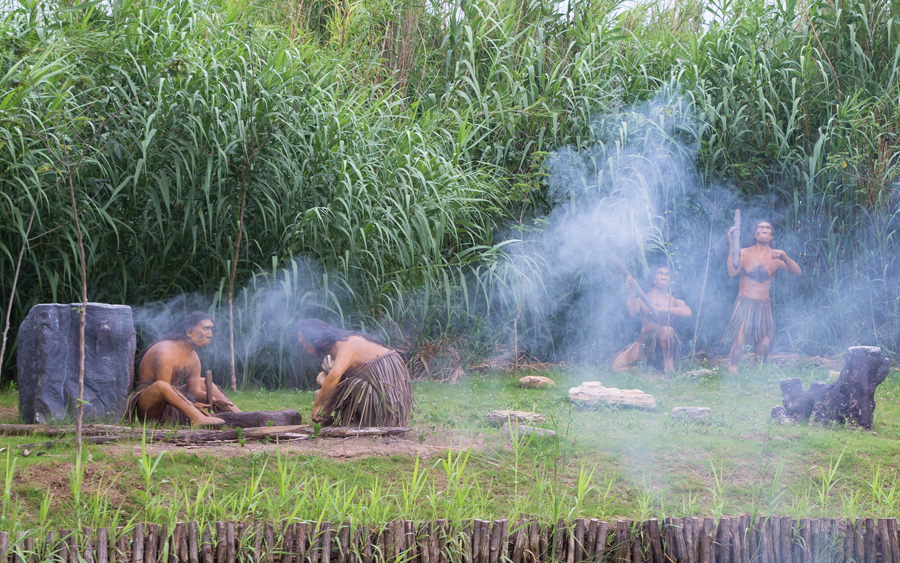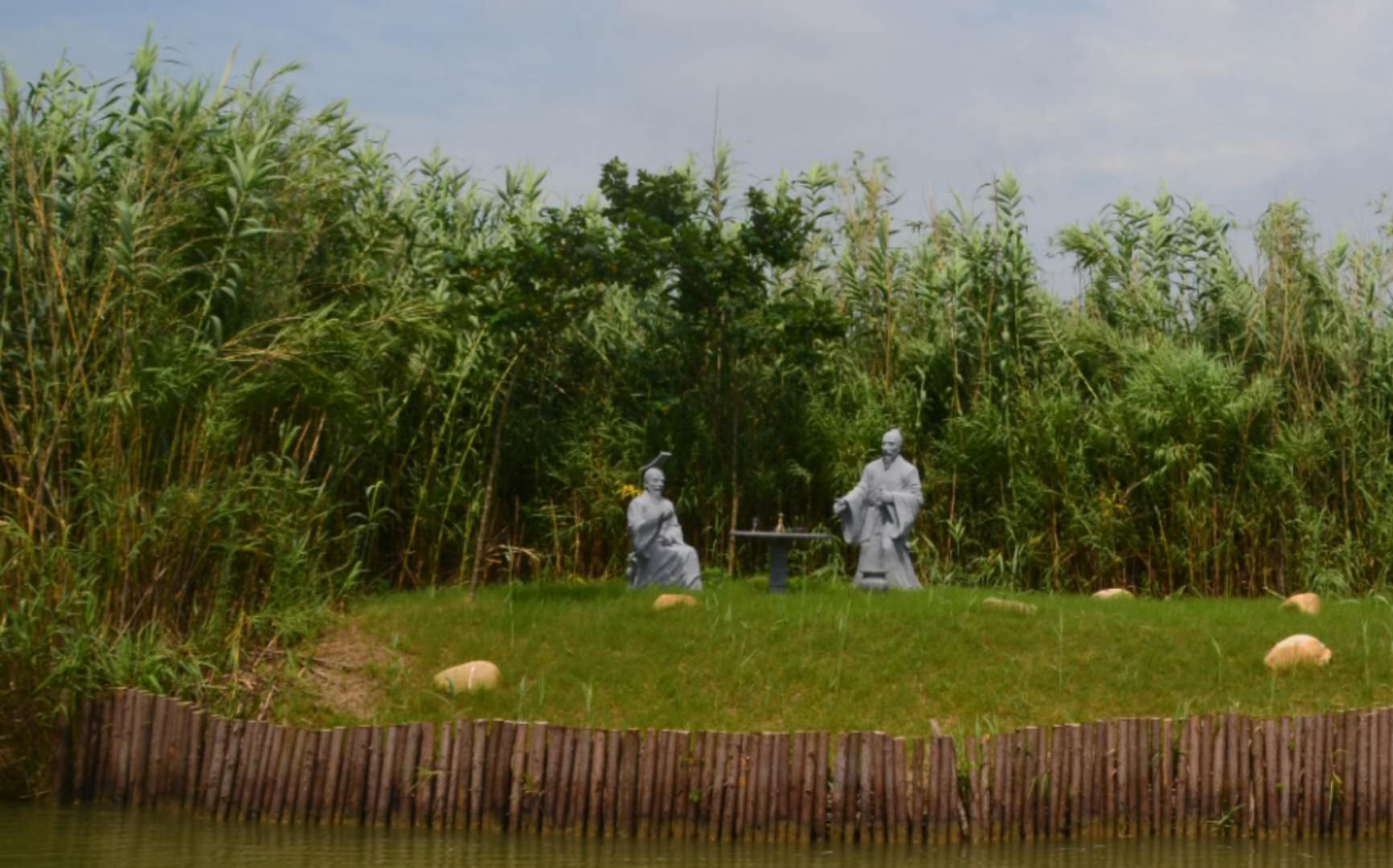Dionysopithecus Shuangouensis
In 1977, Professor Li Chuankui from the Institute of Vertebrate Paleontology and Paleoanthropology, the Chinese Academy of Sciences, came to Shuanggou for archaeology and found a maxillary fossil of a palaeovertebrate in the soil layer near Songlin Village. After some repairs, Professor Chuankui carried out painstaking and careful observation and research and found that this was a gibbon fossil that hadn’t been seen before. Through an analysis and comparison of the morphological features, geological history and geographical factors of the only three molars on the maxilla, it was confirmed that this was a tooth fossil of a gibbon 18 million years ago. Since it was first discovered in Shuanggou, and soaked with wine, it was also named “dionysopithecus shuangouensis”. The dionysopithecus was the first discovery of Neogene gibbon fossil in Asia.
Xiacao Bay Cultural Site
Xiacao Bay Cultural Site is located on the east bank of the Yinhe River of Xiacao Bay, 8 kilometers to southeast of Shuanggou Town, Sihong County, bordering Huaihe River in the south and Hongze Lake in the north. It was the earliest hominid site found in Jiangsu Province. The current status of the site is an ordinary river slope. In 2002, it was identified by the municipal government as a municipal key cultural relic protection unit. In June 1954, Professor Yang Zhongjian, an academician of the Chinese Academy of Sciences, geologist and paleontologist, collected a 15.27cm femur fossil of an ape-man in Xiacao Bay during an inspection tour. It was a fossil of late Pliocene human, dating back to about 40,000-50,000 years ago. It belonged to late homo sapiens and was named “Xiacao Bay Neo-man”. In recent years, experts have carried out many archaeological investigations and scientific excavations in Xiacao Bay and discovered nearly 100 kinds of fossils of Pleistocene and Miocene paleo-vertebrate mammals, many of which were new species and genera. They were called Xiacao Bay fauna. The unearthed dionysopithecus shuangouensis and platodontopithecus jianghuaiensis, in particular, are of great value for the study on the evolution process from ape to man. When geologists investigated the Xiacao Bay site, they found that the soil layer in this region belonged to lacustrine sedimentary area, and was called “Xiacao Bay Kaolin Stratum”. Stratums of its kind were uniformly known as “Xiacao Bay System” and recorded in The Geology of China.

Shunshanji Cultural Site in Meihua Town
The Shunshanji site is located in Shunshanji, Meihua Town, Sihong County, covering a total area of 2,500 square meters. An over-1,000 meter-long ring trench, houses and cemeteries were found and plenty of stoneware, potteries, bone artifacts, pottery sculptures and carbonized rice were unearthed. The unearthed objects can date back to about 8,000 years ago and reflect a relatively complete Neolithic settlement pattern in the Huai River Basin. It was the earliest Neolithic ring trench settlement site in Jiangsu, which pushed the civilization history of Jiangsu forward for about 1,500 years, filled a gap in prehistoric civilization in the lower reaches of the Huaihe River, and was hailed as the root of Jiangsu civilization. The Shunshanji site has striking cultural characteristics in such aspects as the trench settlement, circular ground-type house, the use of production tools such as millstone and grinding ball, etc., rice planting and other means of livelihood. According to its fixed pottery combination, unique cultural aspect and clear historical staging, the cultural relics of this site were named Shunshanji Cultural Site.
Ancient State of Xu
During the Xia, Shang and Zhou Dynasties, China entered an era when vassal states surged one after another. Legend has it that when the Yellow Emperor was in power, Sihong was the fief of Shaohao, the son of the Yellow Emperor, and Shaohao was the leader of Dongyi Tribe. It was recorded in the Chronicle of Sihong that “Qingyang, the name of an ancient state, was the fief of Shaohao (aka Qingyang)”. “Xia Yu divided the whole kingdom into nine states, granted the State of Xu to Bo Yi’s Son, Ruomu and made him viscount of the State of Xu. Sihong belongs to Xuzhou. After surviving Shang and Zhou Dynasties, it was eventually destroyed by the State of Wu at the end of the Spring and Autumn Period. From the time when the first ancestor Ruomu was granted the state to the time when Zhang Yu lost the state, the state had 43 reigns and last more than 1,600 years.
According to historical records, during the Western Zhou Dynasty, the State of Xu was very strong and powerful. Xu Yanwang was once the leader of the Alliance of Nine Barbarian Tribes, “ruled 36 states on land”, “with a territory of 500 li”. Mr. Xu Xusheng, a great historian, made a preliminary definition of the territory of the state of Xu: beliving that “the territory of this clan should be in the present-day Xuzhou, from the vicinity of Hongze Lake in the south, northeast Anhui in the west, and southern Shandong in the north”. There are also various views in the historical circle on the location of the capital of the State of Xu, which can be roughly divided into Tancheng of Shandong, Xucheng of Hongze Lake and Liangwang City in Pizhou.
The elder generation of archaeologists, Zeng Zhaoyu and Yin Huanzhang, in Nanjing Museum also investigated the location of the capital of the ancient State of Xu. According to documentary records and archaeological data, they believed that the capital of the ancient State of Xu might be in Chonggang or Cuiji in Sihong. Because a continuous stretch of West Zhou ruins are distributed in these two areas, of which Guidun site is especially large and have particularly abundant cultural relics. In the villages and towns bordering Hongze Lake, there are also many relics about legends of the State of Xu, such as the sword-hanging platform, where Wu Jizi hung a sword for Xu Jun, Bancheng, which was reportedly the capital of Xu, Xiangcheng, which was reportedly the dressing building of the wife of Xu Yanwang and the ruins of Huanggu’an in Qingyang Town. There was also a folk legend that ancient Xucheng was inundated by Hongze Lake during the Ming and Qing Dynasties. According to a general archaeological survey, nearly 30 Shang and Zhou ruins were discovered in Sihong, almost throughout Sihong, ranking 1st in the surrounding counties and districts. The archaeological data above show that Sihong should be a center for the study of Xu culture.











 Public Security Filing No.:321324402000556
Public Security Filing No.:321324402000556